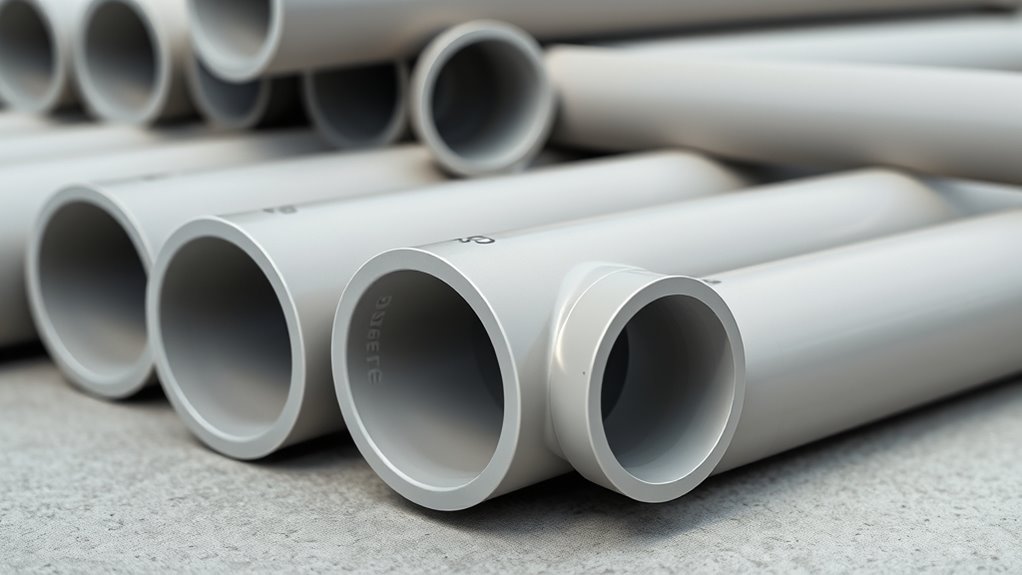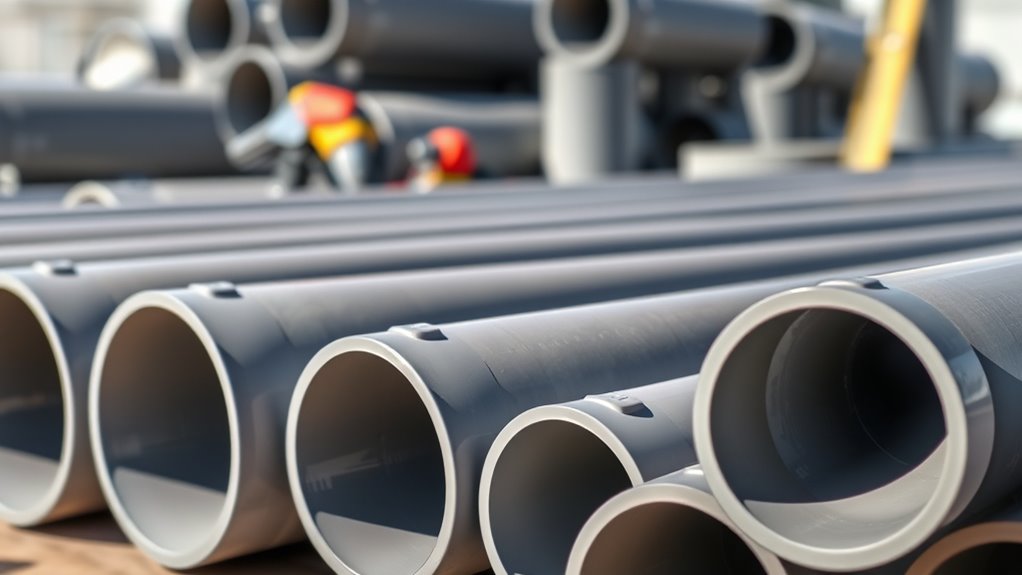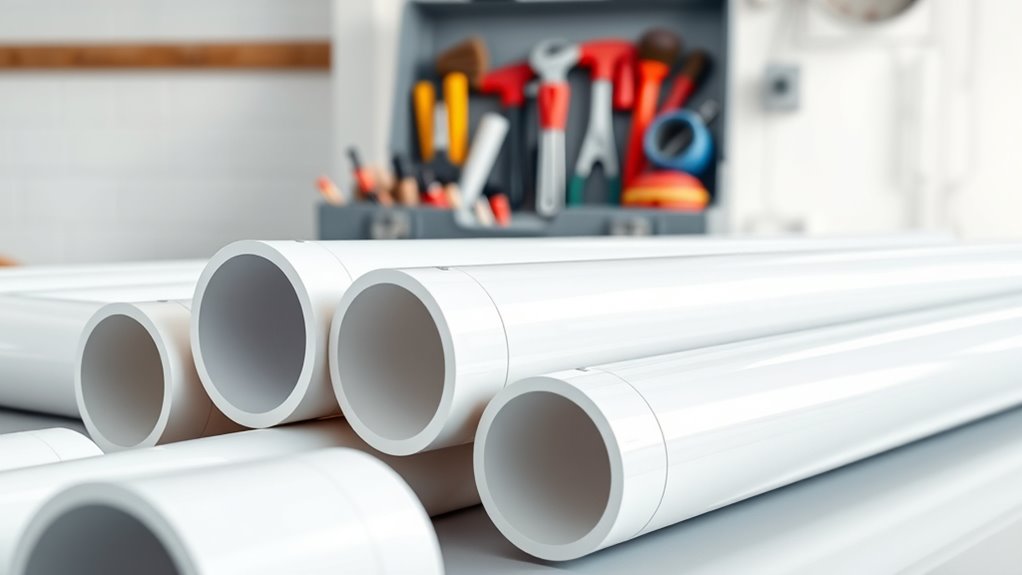Schedule 40 Pipe is a widely recognized plumbing standard characterized by its specific wall thickness, making it suitable for various applications including water supply, drainage, and venting systems. Constructed from materials such as PVC, CPVC, or steel, it offers unique properties like corrosion resistance and durability. Common sizes range from ½ to 12 inches in diameter, and pressure ratings vary based on material. Its cost-effectiveness and easy installation promote its use in both residential and industrial settings, with more details available.
Understanding Schedule 40 Pipe

Schedule 40 pipe is a widely recognized standard in the plumbing and construction industries. This designation indicates the thickness of the pipe walls, which affects its pressure rating and suitability for various applications.
Commonly constructed from materials such as PVC, CPVC, or metal, Schedule 40 pipe is available in various diameters, allowing for flexibility in installation. It is primarily used for water supply lines, drainage systems, and venting applications, demonstrating its versatility.
The classification system helps professionals determine the appropriate pipe for specific projects, ensuring safety and functionality. By adhering to this standard, contractors and engineers can maintain consistency in their work, ultimately contributing to the reliability of plumbing and construction systems across various settings.
Material Composition of Schedule 40 Pipe
The material composition of Schedule 40 pipe is essential for its performance and application.
Typically made from PVC, CPVC, or metal alloys, these materials contribute to the pipe’s strength and durability.
Understanding these components helps in evaluating the suitability of Schedule 40 pipe for various plumbing and construction needs.
Common Materials Used
Pipes classified as Schedule 40 are primarily constructed from materials such as PVC, CPVC, and steel, each offering distinct advantages for various applications.
PVC, or polyvinyl chloride, is lightweight and resistant to corrosion, making it ideal for plumbing and irrigation systems.
CPVC, or chlorinated polyvinyl chloride, is similar to PVC but can withstand higher temperatures, perfect for hot water lines.
Steel, often galvanized or black, provides strength and durability, making it suitable for industrial and construction applications.
Each material’s unique properties guarantee that Schedule 40 pipes can be utilized in a wide range of settings, addressing specific needs such as chemical resistance, pressure handling, and temperature tolerance, thereby enhancing their overall functionality in diverse environments.
Strength and Durability
Strength and durability are critical characteristics of Schedule 40 pipes, heavily influenced by their material composition. Typically constructed from PVC, CPVC, or steel, these materials impart specific mechanical properties that enhance the pipe’s performance under various conditions.
PVC and CPVC provide excellent resistance to corrosion and chemicals, making them suitable for water transport and drainage systems. Steel Schedule 40 pipes offer superior tensile strength, suitable for high-pressure applications.
The wall thickness, standardized in Schedule 40 classification, contributes to the overall durability, allowing the pipes to withstand significant internal pressures and external stresses. This combination of material choice and design specifications guarantees that Schedule 40 pipes maintain structural integrity and longevity in diverse applications, from residential plumbing to industrial settings.
Dimensions and Sizes of Schedule 40 Pipe
The dimensions and sizes of Schedule 40 pipe play an essential role in determining its applications and compatibility with various systems.
Standard pipe dimensions, common size variations, and wall thickness specifications are vital factors to take into account.
Understanding these aspects guarantees peak performance and structural integrity in plumbing and construction projects.
Standard Pipe Dimensions
Schedule 40 pipe is widely recognized for its standard dimensions, which are essential for ensuring compatibility in various plumbing and construction applications.
The dimensions of Schedule 40 pipe are defined by the American National Standards Institute (ANSI) and the American Society for Testing and Materials (ASTM). Typically, the nominal pipe sizes range from 1/2 inch to 12 inches in diameter.
The wall thickness varies according to the pipe diameter, with smaller pipes having thicker walls relative to their size. For instance, a 2-inch Schedule 40 pipe has a wall thickness of 0.154 inches, while a 10-inch pipe has a wall thickness of 0.365 inches.
These standardized dimensions facilitate efficient installation and maintenance across diverse systems.
Common Size Variations
Various size variations of Schedule 40 pipe cater to a wide range of applications, guaranteeing versatility in plumbing and construction projects. Typically, these pipes are available in nominal diameters ranging from ½ inch to 12 inches, with various lengths commonly found in 10-foot and 20-foot sections.
The sizes accommodate different flow requirements and structural needs, allowing for efficient installations in residential, commercial, and industrial settings. Additionally, the compatibility with various fittings and connectors enhances its utility, making Schedule 40 pipe a favored choice among contractors and builders.
The standardized sizing simplifies inventory management and guarantees that professionals can easily source the necessary materials for their projects, leading to streamlined operations and improved project timelines.
Wall Thickness Specifications
When selecting Schedule 40 pipe, understanding wall thickness specifications is vital for ensuring the pipe meets the demands of specific applications.
Schedule 40 pipes are available in various diameters, each corresponding to specific wall thickness measurements. For instance, a ½-inch diameter pipe typically has a wall thickness of 0.109 inches, while a 2-inch diameter pipe has a wall thickness of 0.154 inches.
The wall thickness contributes notably to the pipe’s strength and pressure rating, making it essential for users to select the appropriate size based on their project requirements. This standardization allows for easier compatibility with fittings and other piping systems, ensuring reliability and safety in plumbing, drainage, and industrial applications.
Proper selection of wall thickness directly impacts performance and longevity.
Pressure Ratings and Strength Characteristics
Pressure ratings and strength characteristics are critical factors in the performance of Schedule 40 pipe, determining its suitability for various applications.
Schedule 40 pipe is designed to withstand specific pressure levels, which vary depending on the pipe’s diameter and material composition. For instance, PVC Schedule 40 can handle pressures up to 480 psi for smaller diameters, while larger diameters have lower pressure ratings.
The pipe’s wall thickness contributes to its overall strength, allowing it to resist deformation under pressure. Furthermore, factors such as temperature and the type of fluid being transported can influence its performance.
Understanding these ratings is essential for engineers and contractors to guarantee that Schedule 40 pipe is appropriate for the intended use, ensuring safety and reliability in installations.
Common Applications of Schedule 40 Pipe
Schedule 40 pipe is widely utilized in a range of applications due to its favorable pressure ratings and strength characteristics. Commonly found in residential, commercial, and industrial plumbing systems, it serves as an effective conduit for water, gas, and drainage.
Furthermore, its resistance to corrosion makes it suitable for outdoor and underground installations. Schedule 40 pipe is often employed in irrigation systems, facilitating the distribution of water in agricultural settings.
Additionally, it is used in HVAC systems for ventilation and air conditioning, as well as in fire protection systems where reliable piping is essential.
Its versatility also extends to various manufacturing processes, where it is utilized for creating frames, supports, and structural components in different industries.
Advantages of Using Schedule 40 Pipe

Schedule 40 pipe offers several advantages that make it a popular choice in various applications.
Its cost-effective nature allows for budget-friendly projects, while its versatility accommodates a wide range of uses.
Additionally, the straightforward installation process simplifies deployment, making it accessible for both professionals and DIY enthusiasts.
Cost-Effective Material Choice
Many builders and contractors consistently choose Schedule 40 pipe for its affordability and versatility in various applications. Its cost-effectiveness stems from both the material’s lower price point and its durability, allowing for long-term savings on repairs and replacements. Schedule 40 pipe is readily available, further enhancing its appeal in construction projects.
| Feature | Benefit |
|---|---|
| Material | PVC or CPVC |
| Cost | Lower initial investment |
| Durability | Resistance to corrosion |
This combination of economical pricing and reliable performance makes Schedule 40 pipe a favored choice among professionals, ensuring that projects remain within budget without sacrificing quality.
Versatile Application Range
The versatility of Schedule 40 pipe makes it a popular choice for a wide range of applications in plumbing, irrigation, and construction. Its durability and resistance to corrosion allow it to be utilized in both residential and commercial settings.
Schedule 40 pipe is suitable for carrying potable water, sewage, and drainage, making it vital in plumbing systems. Additionally, its lightweight nature facilitates its use in various irrigation systems, where effective water distribution is essential.
In construction, it can serve structural purposes or be employed in protective casing for electrical wiring. This adaptability guarantees that Schedule 40 pipe remains a preferred option across multiple industries, underscoring its significance and reliability in various projects.
Easy Installation Process
One of the notable advantages of Schedule 40 pipe is its straightforward installation process, which contributes to its widespread use in various applications.
The pipe’s availability in multiple sizes and lengths allows for easy customization to fit specific project requirements. Additionally, Schedule 40 pipe is lightweight, making it manageable for both professionals and DIY enthusiasts.
The compatibility with standard fittings further simplifies connections, reducing the need for specialized tools. Its use of solvent welding or threaded connections enhances the speed of assembly, allowing for quicker project completion.
Installation Guidelines for Schedule 40 Pipe
Proper installation of Schedule 40 pipe is vital for guaranteeing a reliable and efficient plumbing or drainage system. Adhering to specific guidelines can optimize performance and longevity. First, confirm that all surfaces are clean and free from debris before joining pipes. Use appropriate fittings and adhesives as recommended for the material type. Additionally, proper alignment and support are essential to prevent stress and potential leaks.
| Step | Action | Tools Needed |
|---|---|---|
| 1 | Measure and cut pipe | Pipe cutter, measuring tape |
| 2 | Clean and prepare joints | Cleaning solvent |
| 3 | Apply adhesive and connect | Applicator |
| 4 | Secure and support installation | Pipe supports, brackets |
Maintenance and Care for Schedule 40 Pipe

Maintaining Schedule 40 pipe is vital for guaranteeing its longevity and ideal performance in various applications. Regular inspections should be conducted to identify signs of wear, corrosion, or damage.
Cleaning the exterior with a mild detergent and water helps prevent buildup of debris that could lead to deterioration. For joints and fittings, checking for leaks is essential; any detected leaks should be addressed promptly to prevent further issues.
Additionally, avoiding exposure to extreme temperatures and harmful chemicals can prolong the life of the pipe. Proper storage, when not in use, is also important; keeping pipes in a dry, sheltered area minimizes environmental impacts.
Following these maintenance practices guarantees that Schedule 40 pipe remains reliable and functional throughout its lifespan.
Comparison With Other Pipe Schedules
When comparing Schedule 40 pipe to other pipe schedules, it is important to take into account factors such as wall thickness, pressure ratings, and intended applications. Schedule 40 is commonly used in residential and commercial plumbing, while other schedules like Schedule 80 offer thicker walls for higher pressure applications.
| Pipe Schedule | Wall Thickness (inches) | Typical Applications |
|---|---|---|
| Schedule 40 | Varies by diameter | Residential plumbing |
| Schedule 80 | Thicker than Schedule 40 | Industrial applications |
| Schedule 10 | Thinner than Schedule 40 | Low-pressure systems |
| Schedule 160 | Much thicker | High-pressure environments |
| Schedule 20 | Intermediate thickness | General-purpose piping |
This comparison highlights the versatility of Schedule 40 while illustrating when alternative schedules may be more appropriate.
Environmental Considerations and Sustainability
Although the use of Schedule 40 pipe is prevalent in various plumbing applications, environmental considerations and sustainability play a crucial role in its selection and use. The production and disposal of these pipes can impact the environment, necessitating careful evaluation.
Key considerations include:
- Material Source: The environmental footprint of raw materials used in manufacturing.
- Recyclability: Potential for recycling at the end of the pipe’s life cycle.
- Energy Consumption: Energy required during the production and installation processes.
- Chemical Impact: Emissions and pollutants released during manufacturing and use.
- Durability: Longevity of the pipe, which reduces the need for frequent replacements.
These factors contribute to a more sustainable approach to plumbing and infrastructure development.
Conclusion
To sum up, Schedule 40 pipe stands out for its versatility and strength, making it a popular choice in various applications. With a nominal diameter range from ½ inch to 24 inches, this pipe can handle pressures up to 450 PSI, depending on the diameter. Its widespread use in plumbing, irrigation, and industrial systems illustrates its importance. As industries continue to prioritize sustainability, the enduring nature of Schedule 40 pipe contributes greatly to reducing waste and enhancing efficiency in construction and maintenance.

I’m Allen Kim, the chief editor of plumbinginto. I am a mid level plumber and assign to an local firm over 4 years of experience. During the working period, most of my experience is related to the house plumbing. I learned about the thing, when working with most experienced people in this sector, one must be as good as the inspector or better with knowledge of the project as well as the practical aspects of plumbing industry.